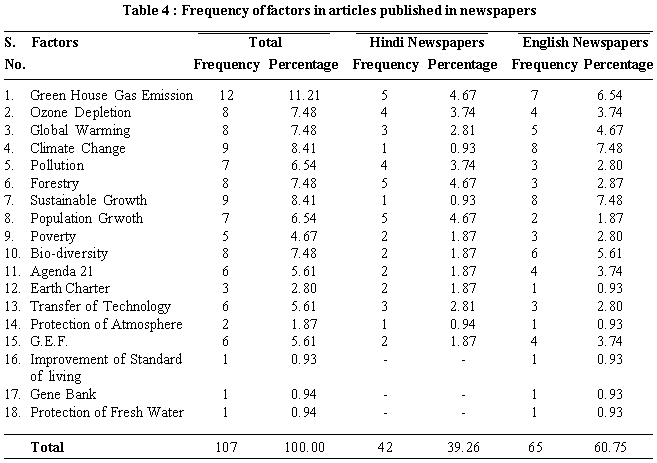It was observed that 107 total frequency
factors appeared in the published matter. The factor which had
been covered to a great extent was green house gas emission
which had a frequency percentage of 11.21. The green house gas
emission is the cause of global warming and climate change. It
is hailing to note that these interrelated matters have been
dealt to a great extent. The frequency percentage of climate
change is 8.41, whereas the global warming and depletion of
ozone are 7.48 each. There are other factors also which have
been highlighted in accordance with their importance like
sustainable growth, bio-diversity convention and forestry. They
are also related to each other. The frequency percentage on
sustainable growth is 8.41 while on bio-diversity and forestry
9.48 each. The pollution, agenda 21, transfer of technology, GEF
and poverty have been widely dealt in the articles as the
frequency percentage of pollution is 6.54 whereas agenda 21,
transfer of technology and GEF are 5.61 each and poverty 4.67
percent. The less importance has been shown towards improvement
of standard of living, gene bank, protection of atmosphere and
fresh water.

Table 4 shows that the frequency percentage
regarding the content in English (60.79) newspapers is higher
than in Hindi dailies (39.26). The English newspapers have
played major role in providing enriched content in comparison to
Hindi dailies. The frequency percentage of climate change is
7.48 in English daily whereas Hindi dailies have dealt it
nominally (0.93). There is higher frequency percentage in
English daily on the factors like green house gas emission,
global warming, bio-diversity convention, agenda 21 and GEF.
Equal stress has been laid on ozone depletion, transfer of
technology and protection of atmosphere. Hindi dailies paid no
attention to improvement of standard of living, gene bank and
protection of fresh water. The Hindi newspapers have higher
frequency percentages in pollution, forestry and population
growth.
Discussion
Newspapers play key role in diffusion of
information and hence they are called the source of information
explosion. The objective of diffusion of information is
highlighted here in a line diagram ahead.
The source of diffusion of information in
relation to the environmental pollution and development during
the Earth Summit period were news, articles, cartoon, etc., as
elucidated in Table 4. It is commendable that out of 122
published items the news, poems and cartoons contained 80. Their
percentage was 65.57. The Hindi and English, both the newspapers
gave high place to news. The headlines and captions used in both
English and Hindi dailies were capable of arousing curiosity.
Table 2 shows that out of 122 published items
there were 33 articles, interviews and speeches (27.05 percent).
The content analysis of the articles shows that there were 122
frequency factors.
The newspapers made critical and intellectual
assessment of the Summit through their editorials. These seven
papers produced 9 editorials.

Observations and Findings
1. The regional newspapers gave sufficient
space to make home the issue of environmental pollution and
subsequent measures during the Summit.
2. The published matter prior and after the
convention were insufficient, as 112 issues, prior to the
convention, published only 5 items on environmental pollution.
Similarly the post convention literature was also scanty as only
8 items were published in 210 issues. The percentage in the
first fortnight was 6.55 and in the next 2.46 only.
3. The content analysis expresses the
qualitative nature of the articles published. The highest
frequency factor percentage was for the green house gas
emission. The weightage to depletion of ozone, global warming
and climate change was also significant.
4. The articles also contained high frequency
factor percentages for sustainable growth, bio-diversity and
forestry. Pollution, agenda 21, transfer of technology, GEF and
poverty got low frequency.
5. Some of the factors were neglected such as
gene bank, improvement of standard of living, protection of
atmosphere and fresh water.
6. The qualitative feature of the publication
was more related to the environmental pollution and its effect
than the issues like improvement in the standard of living and
eradication of poverty.
7. The content analysis shows that the
frequency factors of English daily is too high in comparison to
Hindi newspapers. The cumulative frequency factor percentage of
English dailies is 60.74, whereas in Hindi it is 39.26. The
articles published in English daily comprise of all the factors
with due weightage. The Hindi newspapers have dealt the subject
with less weightage and some of the factors were not discussed.
8. The developing countries are no less
concerned with the sustainable growth, but this did not get due
weightage in the contents published.
9. The regional newspapers had covered the
technical issues more than the policy alternatives. At some
places the consistency was not fully observed.
10. The regional newspapers gave sufficient
space to scientific and technological news and supportive
reading material.
11. It is suggested that science desks should
be established in each newspaper where persons with the
background of science and technology should man the desk. The
newspapers do not give sufficient regular space for
disseminating scientific knowledge. They casually report when
some convention is held or a Day is observed.
12. The communication in science and
technology is not mere reporting of news. It requires indepth
knowledge about various scientific and technological concepts
some people believe that only those with good academic
background in science can perform the job well, which is a
matter of greater debate.